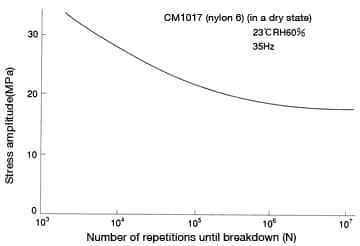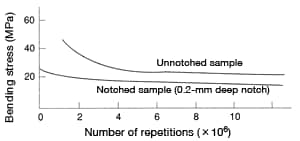- HOME
- Technical Information
- AMILAN™ Nylon Resin
- Fatigue endurance
Fatigue endurance
Materials subjected to fluctuating loads over an extended period of time will fatigue and fail. Figure 47 shows a stress-lifetime curve under a cantilever-bending fatigue test. The conditions used were a sample thickness of 6 mm, a repetitive speed of 35 Hz (plane bending in alternating directions), a temperature of 23±1°C and humidity of 60%RH ±5%.
As you can see, after 107 repetitions, the alternating-direction bending fatigue limit of CM1017 (nylon 6) is 19 MPa.
Table 9 shows the tensile-compressive fatigue test results for nylon 66

Figure 47: Stress-lifetime curve of CM1017 (nylon 6)
| Water absorption (%) |
Temperature (°C) |
Endurance limit (MPa) |
|---|---|---|
| 0 | 73 | 35 |
| 2.5 | 73 | 21 |
| 2.5 | 100 | 14 |

Figure 48: Effects of notches on the fatigue
strength
of nylon 6
When a notch is present, stress is concentrated, which depletes fatigue strength. Also, a higher degree of polymerization results in greater fatigue strength.
Higher repetitive speeds or greater fluctuations in stress result in a great amount of heat generated internally due to hysteresis. Under such circumstances, steps to release heat are needed.